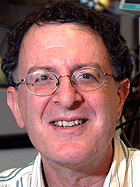An experimental anti-cancer regimen combined a diuretic, a Parkinson’s disease medication and a drug ordinarily used to reverse the effect of sedatives. In research conducted at the School of Medicine, the unusual mixture inhibited the growth of aggressive prostate tumors in laboratory mice.
Although their drug choices may seem capricious, the researchers weren’t randomly pulling drugs from their shelves.

They made their discovery using sophisticated methods for delving into the unique metabolism of cancer cells and then choosing compounds likely to interfere with their growth.
“This study, led by Joseph Ippolito, a very talented M.D./Ph.D. student, demonstrates the importance of looking at tumor metabolism,” said senior author Jeffrey I. Gordon, M.D., director of the Center for Genome Sciences. “Using a broad array of technology, we’ve obtained a view of the tumor cells’ metabolome [the set of small-molecule metabolites found within cells] and revealed aspects that were not expected and could be exploited.”
The findings, published in a recent article in the Proceedings of the National Academy of Sciences, expand upon earlier work by the research group, which demonstrated that aggressive types of neuroendocrine tumors — seen in some types of lung, thyroid and prostate cancers — produce high amounts of a chemical called GABA, a neurotransmitter.
Because of the abundance of GABA in these tumors, the authors previously proposed that the chemical could potentially serve as a marker for poor-prognosis neuroendocrine tumors. But the latest findings also show that the techniques used to decipher the biochemistry of the tumors can be applied to seek drugs that will affect tumor metabolism.
The techniques link DNA microarray technology, which can pinpoint highly active genes in the tumors, to precise measurements of abundant metabolites and their potential byproducts within intact tumor cells using nuclear magnetic resonance spectroscopy and mass spectrometry.
Software programs take this information and provide testable predictions about how these substances might drive the special metabolism of cancerous cells.
Investigating on laboratory mice that develop metastatic tumors of the prostate’s neuroendocrine cells, the researchers discovered that the tumor cells relied on molecules that transmit signals between neurons. They found that the tumor cells respond to GABA as well as to two other neurotransmitters, glycine and glutamate.
“The question was, ‘What are these neural signaling molecules doing in tumor cells found outside the central nervous system?'” lead author Ippolito said.
The researchers demonstrated that the tumor cells have receptors on their surface that recognize these neurotransmitters and are activated by them. In addition, the tumor cells directly convert GABA and glutamate into sources of energy.
Moreover, glycine was involved in a mechanism that increased the amount of fatty acids, an important source of energy, in the bloodstream of the lab mice.
“We showed that the neurotransmitters GABA, glycine and glutamate not only stimulate proliferation of the tumor cells, but they also are able to secure sources of energy for the cells,” Ippolito said. “In a way, the tumor cells eat their own words.”
Having identified a key vulnerability in these aggressive neuroendocrine tumor cells, the researchers looked for a way to exploit it. They selected agents already approved for medical use by the Food and Drug Administration.
Two drugs — amiloride, a diuretic, and carbidopa, used to treat Parkinson’s disease — exert their effects by inhibiting the same mechanisms the research group had identified as important for the tumor cells’ energy-gathering reactions.
They combined these two drugs with a third drug, flumazenil, which is ordinarily used to reverse the effects of sedatives.
Flumazenil binds to GABA receptors on the surface of nerve cells, and the researchers theorized that it could inhibit GABA signaling between tumor cells.
The amiloride-carbidopa-flumazenil combination was administered to mice that had prostate neuroendocrine tumor cells implanted beneath their skin. Compared to mice that didn’t receive the drug therapy, those treated with the combination had 40 percent less tumor growth.
“We propose that this might be a potential therapeutic regimen for patients with aggressive neuroendocrine tumors,” Ippolito said. “Since the drugs are already FDA-approved, they could be more quickly used as experimental therapeutics.”
Examination of gene expression profiles of more than 400 human cancers showed that the genes encoding the enzymes vital to these aggressive neuroendocrine tumors also were expressed at high levels in some non-neuroendocrine cancers.
This suggests that the three-drug therapy could work for many kinds of cancers, according to the study authors.
“This approach is very powerful,” Gordon said. “By combining a variety of experimental and computational methods that monitor the expression of genes encoding enzymes and their biochemical products, we can explore the metabolism of these cells, looking for unusual pathways that might reveal their potential vulnerabilities.
“Then we can see if medications already exist — ones whose mechanism of action is known and whose safety has been established — that can be used to target components of these unusual pathways, test them in animal models of human cancer and if the results look promising, bring them to the patient’s bedside as part of a carefully controlled clinical trial.”